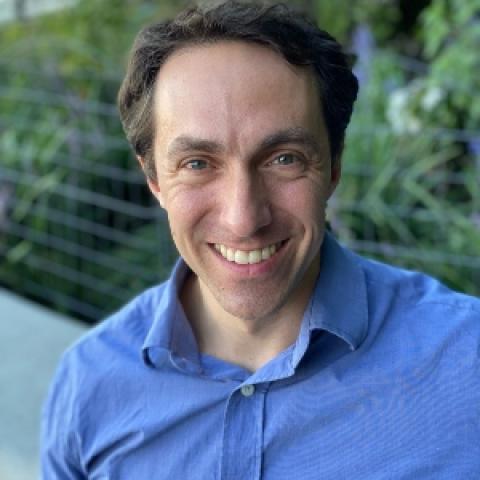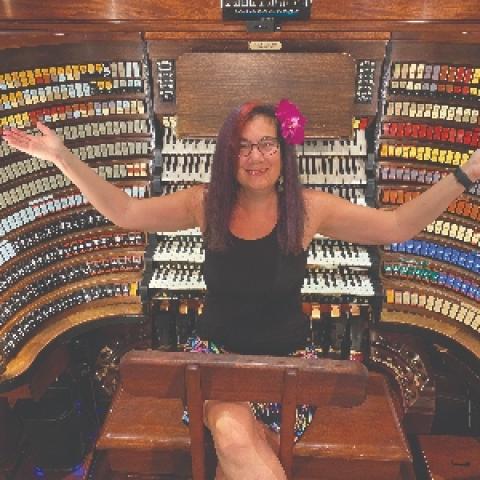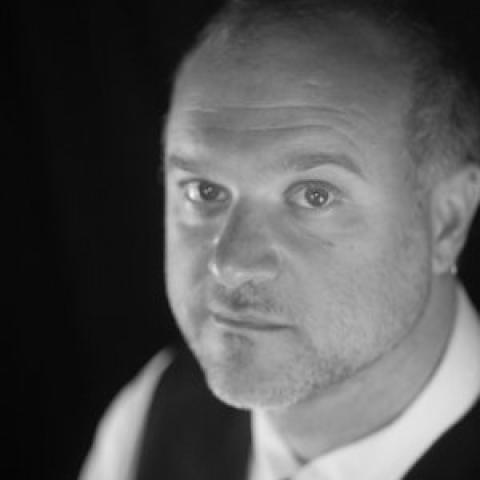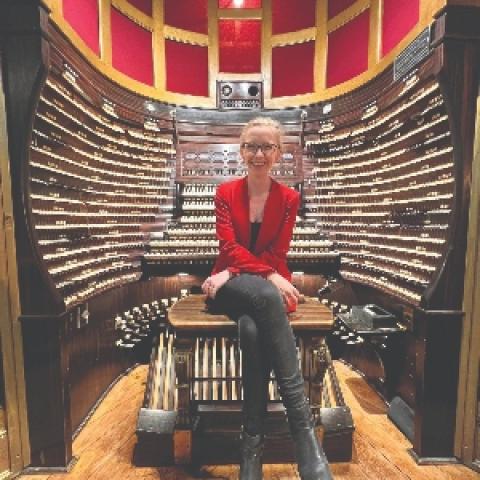Robert McCormick is the organist and choirmaster of Church of the Good Shepherd, Rosemont, Pennsylvania. Previously he held similar positions at Saint Mark’s Church, Locust Street, Philadelphia, Saint Paul’s Church, K Street, in Washington, D.C., and at Saint Mary the Virgin, New York City. He is represented in North America exclusively by Phillip Truckenbrod Concert Artists, LLC.

Editor’s note: Part 1 of this series (Matthew Glandorf) may be found in the May 2022 issue, pages 20–21; Part 2 (Mary Beth Bennett) in the September 2022 issue, pages 12–13; Part 3 (Jason Roberts) in the July 2023 issue, pages 16–17; and Part 4 (Dorothy Papadakos) in the December 2023 issue, pages 12–14.
Introduction
For this article, the fifth in a series on improvisation featuring interviews with American improvisers, we turn to Patrick Scott. Patrick won first prize and audience prize in the American Guild of Organists National Competition in Organ Improvisation (NCOI) in 2014 and is a member of The Diapason’s 20 under 30 class of 2016. Following numerous other distinguished positions, he presently serves as director of music and organist at Grace-St. Luke’s Episcopal Church in Memphis, Tennessee.
Very early in the summer of 2023 I stumbled upon one of Patrick’s improvisation recordings. I was struck by a compelling balance of creativity, originality, and organization. His structure was abundantly clear. A few weeks later, I saw Patrick at the national conference of the Association of Anglican Musicians in Dallas, Texas, and told him how much and why I had enjoyed his recording. “That was all Gerre [Hancock],” he said, ascribing the structure in his improvisation to his legendary teacher at the University of Texas. I wasn’t surprised, knowing that Hancock was a masterful pedagogue and having had one terrific, lengthy lesson with him myself many years ago. Patrick was among his last students, and I was delighted when he agreed to participate in this series.
As Patrick describes in greater detail below, like many who are fluent improvisers, he began playing by ear before learning to read music. While it may not be a universal theme, this is a pattern among many who are comfortable and enjoy improvising. The marvelous Dutch organist-improviser Sietze de Vries discusses this in his online course in improvisation, which may be found on his YouTube channel. He encourages all musicians to improvise, strongly endorses its development in children, and likens learning how to improvise as adults to learning a second language. Like all analogies, I am sure it is only true to a certain extent, but it is a compelling idea: if introduced in childhood, it is much easier than “taking the plunge” in adulthood. (Nonetheless, I, too, strongly wish to encourage everyone and anyone to improvise!)
Discussion
When, how, and why did you start playing by ear and inventing your own music? Did it coincide with your early music training?
I grew up in a small town in southern Mississippi, where we attended what was a large church for our town, with a forty-one-rank Möller organ. The organist there, Betty Polk, had a degree in organ and had complete facility at the instrument; she became my organ teacher throughout high school. I remember being about four years old when she used full organ for the final verse of one of the hymns we were singing. It was one of the most thrilling things I’d ever experienced. I remember going home and trying to pick out the melody on our piano (as well as a four-year-old could). My older brother was already taking lessons, so we were fortunate to have a piano in our home.
I continued doing this for a few weeks until my parents decided to contact my brother’s piano teacher. She said she usually didn’t take students as young as I was, but my mother explained to her that I was playing things by ear at home, and they just weren’t sure how best to nurture that. She asked my parents to bring me to one of my brother’s lessons. I played a hymn for her, probably “What a friend we have in Jesus,” including a very simplified left-hand accompaniment. Ms. Jacobs, the teacher, said that she would take me!
A few months later, I was playing one of my short pieces for the week when Ms. Jacobs realized that while I was playing the piece accurately, it was in the wrong key. We realized that my brother had been playing my pieces for me, after which I memorized them and played them back by ear. So, we had to take a couple of steps back, but I did finally learn to read music. Over my early years, my parents and my teachers were always encouraging my playing by ear. My teachers at each lesson would ask what I had come up with the week prior.
In my home church, all the service music was based on hymns: preludes, postludes, and offertories. So that’s how I modeled the different pieces that I would make up. A little introduction of some sort, a full statement of the melody either on a solo stop or with chords like a hymn, sometimes an interlude, often a key change, and some sort of ending—sometimes a simplified coda, and probably most times, full-blown Hollywood!
How did you employ improvisation in public over the course of your childhood?
My home church was always very open to having people of all ages participate in various ways of making music. In addition to its usual Sunday morning services, there was always a Sunday evening service. In months with five Sundays, we would have an old fashioned “Fifth Sunday Sing.” Surely it was a chance for clergy and musicians to take a break from their weekly task of having to create yet another service, and often it would just simply turn into a talent show.
I was probably five years old the first time I ever played anything; I’m sure it was very basic, but it allowed me to play in public and began to foster what would become a life-calling of being involved with church music. Over the years I would play more and more, beginning to accompany morning and evening services as I got older and more capable. I would learn pieces to play, but most often the preludes or postludes would be things that I would create myself.
Even on Sundays when I wasn’t scheduled to play, our church organist would stop me and ask if I wanted to play the prelude that day. “I don’t have anything prepared,” I would say, and every single time Ms. Betty would look at me and with a glimmer in her eye, say simply, “just make it up!” It wasn’t until I got to college that I realized this was really improvising.
As a child, to the extent that you improvised, did you understand the music theory behind what you were doing, or did that understanding catch up later?
I studied music theory with my teachers, but I really don’t think I took any of this into account while I was playing. I just played what sounded good to my ears. And if it didn’t sound good, I’d make up something else that did.
Was there a watershed moment that inspired you to develop your skills seriously?
Yes! I’ll never forget it! I had become pretty good at this “making up” stuff throughout college. I could create a hymn prelude in almost any style and key and was able to mold it to fit whatever part of the service it needed to be close to.
When I got to graduate school at the University of Texas at Austin, all students were required to study improvisation with Gerre Hancock. I was so excited, but Gerre wasn’t teaching it until the spring semester, and this was the first semester of school. We had the famous French organist Pierre Pincemaille coming to play a recital and work with us in an improvisation masterclass. Gerre asked during the studio class earlier in the week who would like to improvise; immediately every student looked at the floor so as not to make eye contact. He called out a few students and then of course called my name.
I went up afterward and said, “Dr. Hancock, I’ve never studied improvisation before.” And in a way only Gerre Hancock could, he patted my shoulder, smiled, and said, “Oh, Patrico, it’s going to be wonderful!” It turned out he would be away that weekend playing his own recital, as would Judith Hancock, so I really was all on my own.
Then came the day of the masterclass and my turn to play. We had a student fluent in French who was translating for M. Pincemaille. He asked me what form I was planning to improvise in. My look of panic was clearly enough to give away that I had no idea what he was talking about. The translator turned back to him and said, “Free form.” I had prepared a short hymn prelude on SLANE: a brief introduction, the first verse on a solo stop, a modulation, the second verse with chords like a hymn, and finally a little coda after which I called it a day. I finished and M. Pincemaille started screaming with a very thick French accent, “No! No! No! You must always start and end in the same key!”
The horrific embarrassment was only allowed to last for a second as he made me start again. I began the same way, and by the time I got to the end of the first phrase of the hymn melody, he told me to change keys and repeat the first melody line again, and then change keys again, repeat the melody in some other way, over and over and over again. I felt like I had changed keys a million times at this point, and finally he told me to start finding my way back to the home key.
Of course, you probably wouldn’t want to actually modulate that often, but he was trying to break the mold that I had created for myself. It was at that moment that I realized that improvising was so much more than just playing a melody straight through—that embellishment, repetition, form, rhythm, and harmony played such important roles in improvising.
Who were your principal teachers and influences in improvisation? How did you learn from them?
I was very lucky to have been a student of Gerre Hancock while at the University of Texas at Austin. All students would work through Gerre’s textbook, Improvising: How to Master the Art. Through the book, Gerre taught strict form and counterpoint. In addition to carefully working through each chapter of his volume, there are two specific things I remember from lessons that I still think about today.
First, he would ask each student prior to playing what their plan was: what form or keys might be used, and specifically how long it would be. In class, these were just exercises, not long improvisations. So a student could say twenty measures or so. Gerre would then count each measure, counting to ten and then backward from ten.
Even in a short exercise, a student was expected to introduce whatever material was to be used, and then by the tenth measure begin finding a way to the end. It made us think about each measure and what we were doing, forcing us to stay in a structured time signature, not just wandering aimlessly around the keyboard without any organization. We had to build a scaffold for our musical creations, not just haphazardly playing things at random.
Second, Gerre was famous for saying, “There are no wrong notes,” and he meant that! Many times, while working through free improvisations, he would give us scenarios. “Walking through Paris gathering items for a picnic by the Eiffel Tower while car horns honk in the background. Riding an elevator up, it stops, and then it goes back down, maybe it goes quicker on the way down causing panic. Walking through a public space and seeing people you like and then people you don’t like, and one is walking a dog.” They were extremely random scenarios, but then he would allow us to create improvisations that created the scene for those scenarios. It allowed us to be as free as we could ever possibly imagine.
I perhaps learned most by just listening to Gerre play, both in person and through recordings. His harmonic progressions, clever ways of treating the theme, rhythmic excitement, and flawless registrations made me want to run out and improvise immediately.
I remember in graduate school having a small keyboard in my apartment and sitting on the floor listening to his recordings and playing chords repeatedly until I figured out exactly what he was doing. It’s not just playing one “crunchy chord,” it’s more about how it’s approached and what happens after that. Think of the famous chord in David Willcocks’s setting of the last verse of “O Come, All Ye Faithful.” It’s only effective because of the three chords leading up to it. The same is true when trying to figure out different chords in improvising; what happens before and after a great chord is often more important than the chord itself. Gerre’s brilliance always showed forth. But I think the first half of his recording Christmas Improvisations, recorded on the Taylor & Boody in the gallery of Saint Thomas Church Fifth Avenue, presents his most incredible improvisations, offering the most unique and meticulous technique and style.
When did you first improvise in a concert setting?
I’m not sure I entirely remember, but what comes to mind was an improvisation on a submitted theme at the end of my master’s degree recital. It was not a requirement, but many of Gerre’s students would try their hand at this in degree recitals. Gerre would bring out a theme in a sealed envelope like so many did for him at the end of his recitals. The student would have to open the envelope with great suspense and then play through the tune.
I remember mine being the hymn tune HANOVER. Like most on-the-spot improvisations, I don’t remember much about it, but Gerre seemed pleased. I remember him mentioning that I had about three different endings and I could have perhaps wrapped it up sooner; I guess I was having too much fun!
You won first prize in the NCOI; to what extent has that influenced your career and your identity as an improviser? Have you entered other improvisation competitions?
The AGO’s NCOI competition is the only improvisation competition that I’ve been a part of. Preparing for it was quite daunting, but it pushed me to learn so many different styles and quite frankly return to the basics of being able to articulate what you’re planning to do in almost every measure.
I do feel like it was a turning point in my life as a musician, but especially an improviser. I always felt like I was never truly improvising, but just “making things up,” as I would always say. I felt like the word “improvise” was reserved for someone who knew everything they were doing at all times, through form and theory specifically, and I never felt like I had grasped that well enough. I’m not sure I still do today, to be completely honest, but preparing for and winning the competition allowed me to realize that I have put in a decent amount of study for all of this and could articulate what I was doing: specifically in regard to musical form, registration, theory, and so on.
Do you consider yourself to have your own distinct musical language? Is there anything distinctly “American” about your improvising?
I can’t say that I necessarily think of myself as having my own distinct musical language. I do love jazz, and there’s nothing more American than jazz, so hopefully there are some elements that can be heard in some of the harmony that I use. I’d like to think that my love for church music shines through more than anything else: I feel like my improvisations are more likely to sound like the hymn and psalm preludes of Howells, Brahms, Reger, Sowerby, Hancock, Willan, and Bach than the scherzos or huge toccatas of Vierne, Duruflé, and Tournemire. I love those works and composers, and I dabble in improvising in those styles sometimes when I sit down to play. I feel like the former is what’s most likely to come out of my fingers and feet.
Tell us more about imitating specific composers or periods: is it a different process altogether, or a different side of the same coin?
It’s always fun to imitate a composer or create something that sounds like it was composed during a specific period. A free improvisation or even a hymn prelude comes fairly easily to me, but it takes much more concentration to create something that specifically sounds like someone else. The Pachelbel partitas are always enjoyable to imitate and are actually a really solid way to practice improvising. It’s always fun to imitate the twentieth-century French improvisers like Tournemire or Langlais; just push tutti and come crashing down on dense French chords. I also love imitating French Classic composers like Nicolas de Grigny and François Couperin. It’s so satisfying to create a Tierce en taille, a Duo, a Récit de Cromorne, or Basse de Trompette. The counterpoint with these is often tricky and requires a good bit of practice, but it’s always worth it.
Do you compose much? How does improvisation differ from composing to you? Do you prefer one or the other?
I can’t say I compose very much. I wrote a book of hymn reharmonizations and descants published by Selah Publishing Company, and that’s about it. Because I don’t compose very often, it takes quite a bit of time to sit and write what’s going on in my head. I’d like to do more of it in the future. To me, improvising and composing are pretty much the same, because before I could compose anything, I’d have to play it first and figure it out. The problem comes when I can’t remember what I improvised the first time in order to write it down. I clearly prefer improvising to composing!
Conclusion
Patrick Scott’s humility came through when he wrote, “I felt like the word ‘improvise’ was reserved for someone who knew everything they were doing at all times, through form and theory specifically, and I never felt like I had grasped that well enough. I’m not sure I still do today, to be completely honest. . . .” While I (and anyone who hears him, surely) would say that Patrick is far more than worthy of being considered an extremely fine improviser, he does remind us of the adage, “The more one learns, the more one realizes what one doesn’t know.” I have learned a great deal from distinguished colleagues who have participated in this series thus far and look forward to learning even more as the series continues. Hearing their experiences, how they gained their skills, is at once informative and inspiring.
There are as many ways to improvise as there are to make music in general, yet most would agree that learning key skills in harmony, counterpoint, and form is essential to truly begin to unlock one’s potential. Along those lines, I recently shared on Facebook and Instagram a succession of posts on the above. I was pleasantly surprised that the first of them, especially, was shared very well beyond my own group of friends and followers. To follow what Patrick has said, and what he learned from the great Gerre Hancock, I conclude this article by incorporating some of my suggestions here, not necessarily in a particular order, except that the first six are under the banner of keyboard harmony and counterpoint, before moving on to form:
1. Be able to comfortably harmonize (using principles of sound voice leading) major and minor scales in all keys.
2. Practice simple circle of fifths sequences to be able to modulate quickly from a given key to any other key.
3. Learn to transpose any hymn into any and every other key, at sight.
4. Practice transposing to the Dorian, Phrygian, Lydian, and Mixolydian modes, beginning on all pitches.
5. Learn to play figured bass.
6. Learn to read open score of four or more parts, especially works by great polyphonists.
7. Play as many great organ works as possible to build technique and to deepen one’s musical vocabulary. Using familiar tunes or themes, imitate as many of these works as possible when practicing improvisation.
8. Practice constructing phrases comprising only four bars. Begin with simple, stepwise melodies; count aloud. Repeat this exercise frequently. Then improvise a phrase ending in the dominant (a half cadence) followed by one ending in the tonic (specifically, an authentic cadence). Start with melody only, and then add simple harmony. Two phrases make a period; depending on how similar the phrases are, the period will either be parallel or contrasting.
9. After gaining some degree of comfort with the above, improvise a new phrase based on the above, only in a closely related key (relative or dominant). End that new phrase with a half cadence, then add yet another phrase ending with an authentic cadence in that related key. Keep counting aloud as you play!
10. Try to memorize these phrases as best you can. Do not be reluctant to make notes for yourself. Repeat the first period, perhaps with some elaboration, like passing tones or simple ornaments.
11. If desired, add a four-measure introduction, interludes, and a coda (all comprising four measures). Keep counting. These may be very simple, just basic accompaniment figures. Keep counting!
12. Putting together numbers 8–11 above results in one of the simplest musical forms, a ternary or
song form.
All the above was drilled into me by McNeil Robinson in regular lessons over an extended period (along with much else) and must be practiced as much as possible. Gerre Hancock was also a force in solidifying this in my mind, via that one extremely long lesson, a masterclass or two, and his textbook.
I am grateful to Patrick Scott for sharing so much wisdom with us in his interview. I look forward to what we will learn in future interviews.






